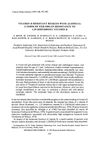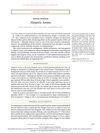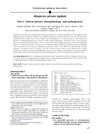TLDR Intravenous and oral calcium effectively treated vitamin D dependent rickets type II, improving growth and bone health.
The study assessed the effectiveness of intravenous high-dose calcium infusions followed by high-dose oral calcium in treating vitamin D dependent rickets type II (VDDRII) in two siblings. The treatment normalized calcium and phosphate levels within 3-5 days and alkaline phosphatase and PTH levels within 15-20 months, with radiological healing observed in 42 days. The elder sister received daily infusions for 3-5 months, and the younger brother for 2 months, both followed by weekly infusions and maintenance on oral calcium. The treatment led to complete biochemical and radiological healing, improved height, and no evidence of nephrocalcinosis or kidney function deterioration. Early treatment was crucial for better growth and prevention of bone deformities, and it may also improve alopecia, though the mechanism requires further investigation.
100 citations
,
October 1986 in “Clinical Endocrinology” Alopecia indicates more severe resistance to 1,25-dihydroxyvitamin D.
11 citations
,
May 1985 in “Archives of Dermatology” Calcitriol-resistant rickets is an inherited disorder that affects hair growth and causes hair loss.
110 citations
,
November 1984 in “The American Journal of Medicine” A genetic defect in vitamin D receptors causes severe rickets and hair loss in children, but some heal as they age.
88 citations
,
October 1983 in “The Journal of clinical endocrinology and metabolism/Journal of clinical endocrinology & metabolism” Patients with this syndrome can have different responses and worsening resistance to treatment over time.
 82 citations
,
April 1981 in “Clinical endocrinology”
82 citations
,
April 1981 in “Clinical endocrinology” A girl with rickets and hair loss was found to have a rare condition where her body didn't respond to vitamin D treatment.
170 citations
,
May 1979 in “The journal of pediatrics/The Journal of pediatrics” Two sisters with rickets and hair loss had a genetic issue with vitamin D processing, and only improved when given phosphorus supplements.
717 citations
,
June 2010 in “Nature” Alopecia areata involves both innate and adaptive immunity, with specific genes linked to the disease.
701 citations
,
August 2014 in “Nature medicine” Alopecia areata can be reversed by JAK inhibitors, promoting hair regrowth.
519 citations
,
October 1998 in “Endocrinology” Diet can prevent bone issues but not hair loss in mice lacking vitamin D receptors.
 421 citations
,
April 2012 in “The New England Journal of Medicine”
421 citations
,
April 2012 in “The New England Journal of Medicine” Alopecia Areata is an autoimmune condition causing hair loss with no cure and treatments that often don't work well.
412 citations
,
January 1998 in “Science” A mutation in the human hairless gene causes alopecia universalis.
 391 citations
,
January 2010 in “Journal of The American Academy of Dermatology”
391 citations
,
January 2010 in “Journal of The American Academy of Dermatology” Half of people with Alopecia Areata may see hair regrowth within a year without treatment, but recovery is unpredictable.


